A History of the County of Hampshire: Volume 4. Originally published by Victoria County History, London, 1911.
This free content was digitised by double rekeying. All rights reserved.
'Parishes: Monk Sherborne', in A History of the County of Hampshire: Volume 4, ed. William Page (London, 1911), British History Online https://prod.british-history.ac.uk/vch/hants/vol4/pp231-238 [accessed 7 February 2025].
'Parishes: Monk Sherborne', in A History of the County of Hampshire: Volume 4. Edited by William Page (London, 1911), British History Online, accessed February 7, 2025, https://prod.british-history.ac.uk/vch/hants/vol4/pp231-238.
"Parishes: Monk Sherborne". A History of the County of Hampshire: Volume 4. Ed. William Page (London, 1911), British History Online. Web. 7 February 2025. https://prod.british-history.ac.uk/vch/hants/vol4/pp231-238.
In this section
MONK SHERBORNE
Sireborne (xi cent.); Shireburn, Sherbourne, Sherborn Monks (xiv cent.); Westshirbourne (xv cent.).
The parish of Monk Sherborne lies to the north of Wootton St. Lawrence and west of Sherborne St. John: it covers an area of 2,045 acres. The road from Kingsclere runs through the southern part of the parish to Basingstoke, and the point at which it enters Monk Sherborne, near Piccadilly Hill, is marked on one side by a stone and on the other by an oak tree which stands a little to the south of the road.
The village of Monk Sherborne stands close to the Monk Sherborne Wood in the east of the parish at the crossing of Kiln Lane and Stokes Lane: the church of All Saints stands at the southern end of the village, and the Manor Farm is close to it. The parish pound was still standing in 1877.
The Priory, now the residence of Major-General Lukin, is at the northern extremity of the parish, close to Pamber, the inhabitants of which still use the Priory Church. The Priory Farm stands close by: it was once surrounded by a moat, the track of which is still to be seen.
The Chineham estate forms a detached portion of Monk Sherborne 3 miles to the south-east, and lies between the two parts of Basing parish. It is crossed by the main road from Basingstoke to Reading: the farm itself stands at a little distance from this road.
Woodgarston is also a tithing in Monk Sherborne, and is 2 miles south-west of the village. By a Local Government Board Order of 1879 six detached portions of the parish were in 1881 transferred to Wootton St. Lawrence.
Monk Sherborne common lands were inclosed in 1793 under the Act of the preceding year, (fn. 1) and other common lands in the parish, known as Great Woods, Privett Green, Salter's Heath, Stony Heath, and West Heath, were inclosed in 1832 under a Private Act of 1829. (fn. 2) The soil and subsoil are chalk and clay, and the chief crops are wheat, barley and roots.
According to the returns of 1905 about four-sevenths of the parish were arable land, about two-sevenths permanent grass and one-seventh woodland. (fn. 3)
The following place-names occur in local records:—La Firugeden, la Bene (fn. 4) (xiv cent.), Bulscroft, Shothanger Copse. (fn. 5)
Manors
The manor of MONK SHERBORNE was held in the reign of Edward the Confessor as an alod of the king by Alnod Cild, (fn. 6) and belonged at the time of the Domesday Survey to Hugh de Port, (fn. 7) whose son Henry gave it to the priory which he founded there as a cell of St. Vigor at Cerisy in Normandy. (fn. 8)
Though subject to St. Vigor, the priory of Sherborne seems to have enjoyed a certain degree of independence, for the prior and convent were accepted by the Bishops of Winchester as patrons of the living of Church Oakley. (fn. 9) It was, however, regarded throughout as an alien priory by the civil authorities, and was taken into the king's hands in the 14th century on account of the war with France (fn. 10); though the custody of the land was granted to the prior during the royal pleasure for the payment of a yearly ferm.
On the forfeiture of Monk Sherborne as an alien priory King Edward IV granted the manor in 1462 to the Hospital of St. Julian, commonly called God's House, at Southampton. (fn. 11) This house had been granted to Queen's College, Oxford, by King Edward III, (fn. 12) whose charter had subsequently been confirmed by Richard II, (fn. 13) and the lands and muniments of Monk Sherborne Priory consequently came into the hands of the Provost and fellows of that college.
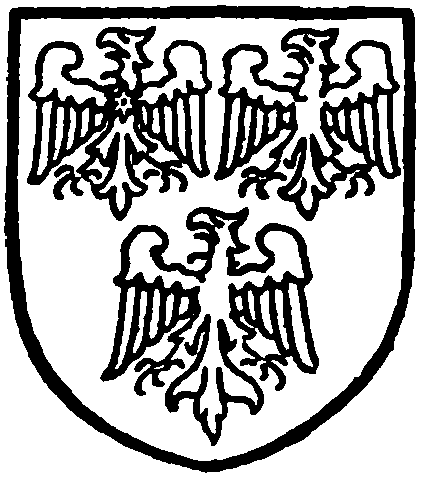
Queen's College, Oxford. Argent three eagles gules with a molet of six points or on the breast of the dexter eagle.
In 1473 the estate was granted to Eton College by Edward IV, (fn. 14) but the deed seems to have been vacated by reason of the former grant, for Queen's College remained in possession, and its provost and fellows are the lords of the manor at the present day.
The manor of CHINEHAM (Chinham, xi cent.; Chynnham, Chynham, xiv cent.) was held of Hugh de Port in 1086 by Aghemund, (fn. 15) who had himself held it of King Edward the Confessor (fn. 16) It was granted by Adam de Port and the Prior and convent of Sherborne to William, whose son and namesake obtained a confirmation of the grant from William St. John. (fn. 17)
In 1272 the lord of the manor was William de Chineham, (fn. 18) who died before 1316. He was succeeded by his son Richard, (fn. 19) who seems to have made enemies, for ' the houses and goods in his manor of Chineham ' were burnt in 1317, (fn. 20) whereupon a commission of oyer and terminer touching the incendiaries was issued.
Richard de Chineham died before 1346, (fn. 21) for in that year the estate was held by his son John (fn. 22) : it subsequently passed to William Brocas, who was seised of it in 1428, (fn. 23) but conveyed it before 1431 to William Warblington of Sherfield-upon-Loddon. (fn. 24) In 1444 William settled it on himself and his wife Margaret in tail with contingent remainder to Henry Puttenham, his first cousin. (fn. 25) He died in 1460., (fn. 26) but his widow survived until 1484, when she was succeeded by William, the son and heir of Henry Puttenham. (fn. 27)
Richard, the grandson of William Puttenham, was seised of the manor of Chineham in 1552, (fn. 28) in which year he settled it on himself and his wife Mary and their issue, with remainder to his own right heirs (fn. 29); but after this date the history of the holding becomes obscure. (fn. 30)
In 1747 John Harwood, William Hunt, Simon Boult and James King and their wives dealt with the manor, which they quitclaimed to Thomas Cowslad, (fn. 31) a member of a family which had long been established at Basingstoke. (fn. 32) The estate passed shortly afterwards to William Earl of Dartmouth, who with his wife Frances Catherine, the daughter and heiress of Sir Charles Gunter Nicholle, was vouchee in a recovery of 1755. (fn. 33) George Viscount Lewisham, the eldest son of the Earl of Dartmouth, was the vouchee in a recovery of 1786. (fn. 34) At the present day Chineham belongs to Lord Bolton, having been purchased about seventy years ago by the late Lord Bolton from Mrs. Hasker, whose husband had purchased it from Lord Dartmouth. (fn. 35)
The manor of WOODGARSTON (Wealagœrstune, x cent.; Wudegarestone, Wodcastone, xii cent.; Wodegarstone, xiii cent.; Wodgaston, Woodcastle, xvi cent.) was probably included in the manor of Sherborne at the time of the Domesday Survey, but it was not among the lands granted to the priory. In 945 King Edmund had granted 24 'jugera' of land in the place called ' Wealagcerstune ' to Æthelnod his priest, (fn. 36) and this probably represented the latermanor.
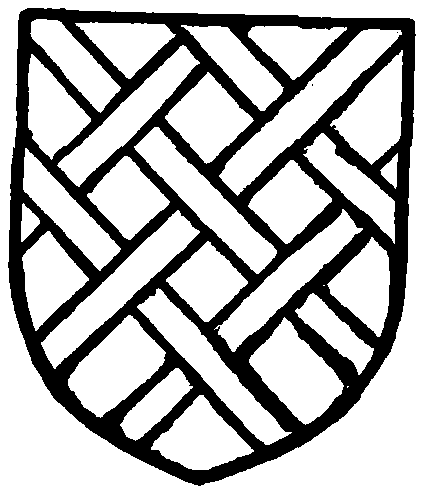
Scures. Azure fretty or.
In the reign of Henry I John de Port enfeoffed Matthew de Scures, (fn. 37) and towards the end of the 12th century another Matthew, who was perhaps the great-grandson of the first feoffee, settled Woodgarston with the consent of Roger his heir upon his younger son and namesake. (fn. 38) In 1226 James de Scures, the son of the last Matthew, was lord of the manor: in that year he obtained licence from the pope to have Mass celebrated three times a week in his chapel at Woodgarston by the Prior of Sherborne. (fn. 39) Richard de Scures, who was perhaps the grandson of James, was living in 1314, (fn. 40) but in 1331 Beatrice the daughter of Sir John de Scures was dealing with the manor, which she leased to Roger Fyfehide, (fn. 41) whose widow Edith obtained an extension of the lease in 1340. (fn. 42)
In 1336 John de Scures, who was afterwards knighted, settled the estate on himself, with remainder to Roger his son, and after Roger's death to his own children by his wife Sibyl. (fn. 43) Sir John was sheriff of Hants from 1321–38, and knight of the shire in three Parliaments (fn. 44) : he seems to have outlived his son Roger, for at his death in 1354 he was seised of Woodgarston Manor, which he left to his son John, then aged seventeen. (fn. 45) John de Scures died childless in 1381, (fn. 46) when he was succeeded by his sister Sibyl, the wife of John Uvedale, (fn. 47) who leased the estate in 1402 to Robert Gerard. (fn. 48) John Uvedale died before 1417 (fn. 49) : his heir was his son William, sheriff of Surrey in 1429, (fn. 50) but Woodgarston appears to have been settled on his younger son John, who was seised of the manor in 1428. (fn. 51) This John Uvedale was four times sheriff of Hants, viz. in 1419, 1422, 1426 and 1433. (fn. 52) In 1417 he received a mandate on the occasion of making an array against the arms of Spain in expectation of an invasion. (fn. 53) On the death of his brother William he succeeded to the manor of Wickham (fn. 54) (q.v.), the descent of which Woodgarston followed until 1619, when it was sold to William Wither of Manydown in the parish of Wootton St. Lawrence. (fn. 55)
William Wither died seised of the manor in 1620 (fn. 56) : his heir was his son and namesake, who left two children, a daughter Dorothy who married Lovelace Bigg of Chilton Foliat (co. Wilts.) in 1684, (fn. 57) and a son and heir William, whose wife was Mary the daughter and heiress of his kinsman George Wither. (fn. 58) The son and namesake of this William succeeded to Woodgarston and died in 1732. (fn. 59) His cousin, another William, who was his heir, died unmarried in 1789, (fn. 60) when the estate passed to Lovelace Bigg, the grandson of Dorothy, who thereon assumed the name of Wither. (fn. 61) Mr. Bigg-Wither was succeeded in 1813 by his second but eldest surviving son Harris, (fn. 62) whose son and heir, another Lovelace, sold the property in 1871 to Sir Edward Bates bart. (fn. 63)
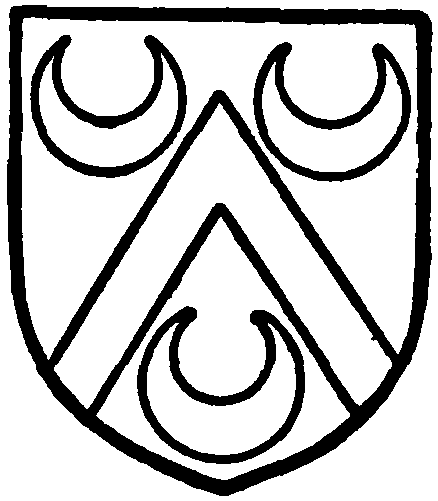
Wither. Argent a cheveron gules between three crescents sable.
Sir Edward Bates died in 1896, (fn. 64) leaving as his heir his son Sir Edward Percy Bates, whose younger son, Mr. Sydney Eggers Bates, at the present day resides at Woodgarston.
In the 14th century the Atte Moure family owned land in Monk Sherborne, (fn. 65) which subsequently followed the same descent as their holdings in Pamber and Tadley (fn. 66) (q.v.), and has been known as the 'manor' of WEST SHERBORNE since the 17th century.
Churches
The church of ALL SAINTS consists of a chancel 22 ft. by 17 ft., and a nave 60 ft. 2 in. by 22 ft. 6 in., with a south-east vestry built in 1852, and a north porch. The whole of the walling, with the exception of the east wall of the chancel, the west end of the nave and the small vestry, appears early, where it can be seen free of ivy or plaster, and is of flint in herring-bone courses. No ornamental detail in the church suggests a date earlier than the second quarter of the 12 th century, but in the north wall of the nave are traces of a window just above and to the west of the north doorway, which must almost certainly have been cut into by the outer head of the doorway, and is therefore probably earlier than it. The doorway is of c. 1140–50, so the window and all the early walling may date from the beginning of the 12th century.
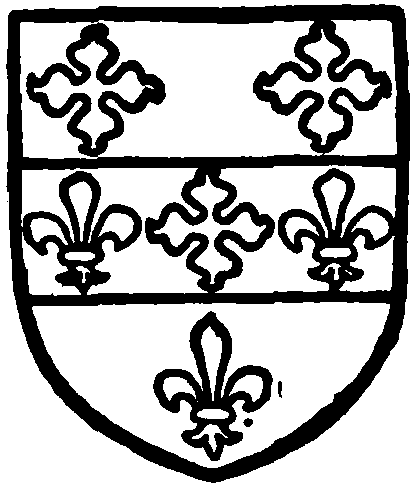
Bates, baronet. Argent a fesse between two quatrefoilsin the chief and a fleur de lis in the foot azure with a quatre-foil between two feurs de lis argent on the fesse.
In the east wall of the chancel are the jambs of a wide blocked and nearly destroyed arch of c. 1140, the chancel arch being of the same date, and it seems that there was formerly a sanctuary, whether square or apsidal, east of the present chancel, the east wall of which is built up of pieces of shafts, arches, &c, of 12th-century date. The present east window, c. 1340, gives the possible date of its destruction. This sanctuary, with the chancel and a north doorway, seems to have been added about 1140, while of earlier work one north window of the chancel and parts of two in the nave are to be seen. The lengthening of the nave by a few feet perhaps dates from the 14th century, and the external north-west stair turret is doubtless an addition of this time. The north porch is also a fine specimen of 14th-century woodwork.
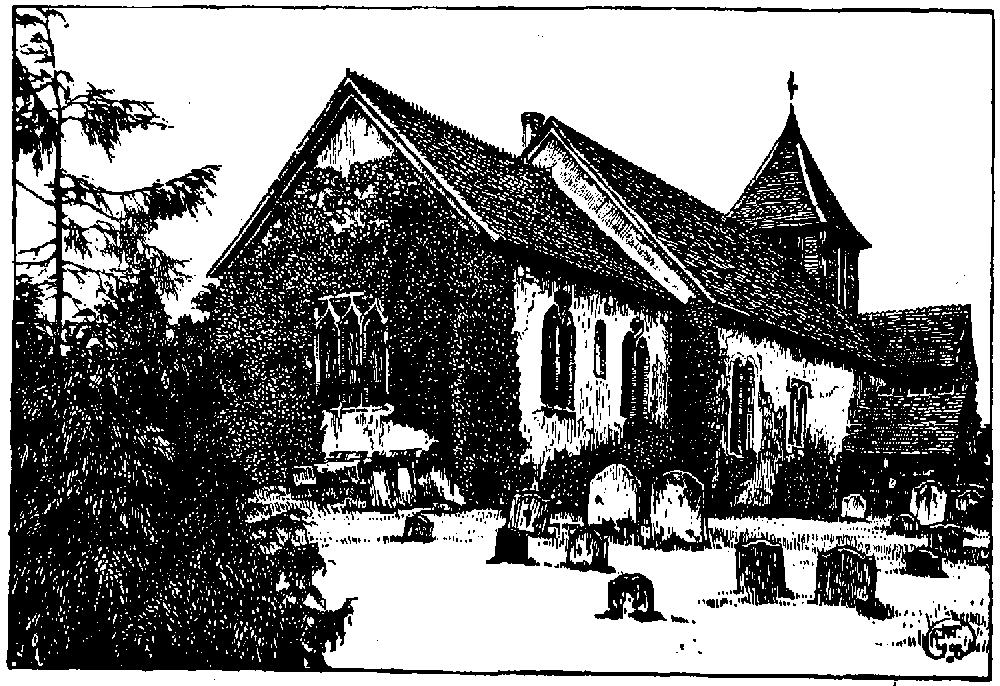
Monk Sherborne: All Saints' Church from the North-east
The east window of the chancel is of mid-14th-century date, of three trefoiled lights under a square head; the remains of the 12th-century arch on either side of it show an outer order of a single line of zigzag between two rolls, and a capital with palmette foliage and channelled abacus.
The early window in the middle of the north wall is round-headed with a small chamfer at the outer wall face and a wide internal splay. On either side of it are early 14th-century windows with two trefoiled lights and a trefoil over, but no inclosing arch. On the south side are like windows, and between them a blocked 13th-century lancet, but the history of this wall is complicated by the existence at its west end of the springing of an arch or perhaps the west splay of a low side window, which shows that some alterations have here taken place. At the east end the masonry bonding with the blocked 12th-century jamb in the east wall, and looking like the jamb of a contemporary arch opening southwards, suggests the former existence of a south chapel here, but if so it must have been destroyed before the 13th-century window was inserted. There are no sedilia or piscinae, but in the vestry a late 12th-century pillar piscina is to be seen, and in the east splays of the north-east and south-east windows of the chancel are blocks of stone which probably carried the ends of a wooden beam, forming part of a screen across the east end of the chancel, and cutting off a narrow strip for use as a vestry.
The chancel arch is semicircular and of two square orders to the west and one to the east. The jambs are similarly arranged and have half-round shafts to the inner order and smaller complete shafts to the outer. The capitals of the latter are enriched with volutes and palmettes like that remaining at the east of the chancel, while those of the former are scalloped and have in the middle a grotesque head, the teeth of which rest upon the necking. A channelled abacus also like that already noted runs round both orders.
Near the east end of the north wall of the nave is a window of two trefoiled lights. The jambs are chamfered and rebated and may be of 13th-century date. The heads, however, are clumsy trefoiled openings, widened by the insertion of a stone at their crowns, and are probably late insertions, as they do not fit the jamb section. West of this is a 15th-century window of two cinquefoiled lights with moulded head, jambs and mullion and a square-headed external label. Its west jamb cuts into the lines of an original window, high in the wall, whose west jamb may be seen inside the church. The north door is some 16 ft. west of the centre of the wall. It is of two orders, the outer having a zigzag on both planes, the inner a roll, inclosing a tympanum of plastered rubble which has had a masonry pattern of lozenges in red; the large cambered lintel below is plain, but bears traces of painted decoration, perhaps a scroll pattern with a central medallion. The jambs of the outer order have circular shafts with scalloped capitals of fully developed style. Over the doorway are remains of a stepped string ornamented with billets and resting on head corbels, an unusual detail. It is unfortunately much damaged by the roof of the pretty 14th-century wooden porch which now stands in front of the door. In the east jamb of the door, inside the church, is a hollow for the back of a holy water stone. Immediately west of the door is a single-light window with a four-centred head, probably 15th-century work, and partly over the lines of an original window, whose east jamb remains.
At the east end of the south wall is a round-headed modern archway of 12th-century design to the vestry, which is partly filled by a dwarf wall. The entrance to the vestry, which was built in 1852, is by a small doorway, apparently formerly opening to a rood stair on the outer face of the wall. It seems of 15 th-century date; in it is hung a modern door with two pieces of early 17th-century panels worked into it. West of this are two two-light windows. The first is of two ogee trefoiled lights rebated internally for shutters, and retaining parts of the hanging hooks, and probably of 14th-century date, while the second is of the same date and detail as the window immediately east of the north door, but lacks the external label. There is no trace of a south door to the nave. The whole of the west end of the nave is raised a couple of steps above the general level and is railed off as a ringing space by a good 17th-century balustrade The west bell-turret over this bay of the nave has been rebuilt and rests on four new posts which stand on the floor of the church. On the north is a small doorway to the belfry stairs with a clumsy head of late date. In the west wall is a 15th-century window of three cinquefoiled lights with a square-headed external label. Below this is a door of the same date with a two-centred hollow-chamfered head.
The font stands near the north door of the nave; its bowl, which is the only old part, of c. 1230, is of rounded form standing on three small circular marble shafts, with plain capitals, and a large circular stem. Between the corner shafts on the lower edge of the bowl are three heads carved in high relief, one only of which is old. It was given a new base in 1887.
There is a good wooden screen across the chancel of 15th-century date but very much restored in 1887, when it was also lengthened. It is of very solid character, and consists of four traceried bays or panels on either side of an arched doorway with pierced trefoils in the spandrels. The cresting and nearly all the side bays are modern. The seating is in great part old work reframed and recut about 1852; its style suggests a 16th-century origin. There is also a bench front of early 17th-century date west of the north door of the nave, and the pulpit, which has panels of flat arabesque carving, was set up by William Dobson, rector, whose epitaph is given below. The ringing space at the west end of the nave is railed off by late 17th-century moulded rails with turned balusters. The roofs are modern (1887), that of the chancel panelled, that of the nave plain and of open timber construction. The bell-cot has been reconstructed in modern times, but incorporates some old materials. The fittings of the chancel are all modern, but of excellent character, the organ and case being particularly satisfactory in design and workmanship. The north door is largely old and has a pair of very fine wrought strap hinges of late 14th-century date worked into fleurs de lis.
On the north wall of the nave is a small brass plate with the inscription; ' Here lyes expecting ye second coming of our saviour ye body of William Dobson a painful servant of God and sometime rector of this parish who exchanged earth for Heaven the first of March anno domini 1653.' The arms given are a cheveron between three fleurs de lis impaling a voided lozenge between three roundels. Near it is another brass recording the bequests in 1674 by Thomas Symson of Sherborne St. John of 'fifteen pounds yearly, so long as the world shall endure,' to be divided between the poor of Sherborne St. John, Monk Sherborne, Wootton St. Lawrence, Baughurst, Pamber and Tadley; the money to be derived from the testator's land in 'Monks Sherborn known as Hill House and... in Bagehurst late Edward Hillcup.'
The tower contains five bells, the treble, second and fourth cast by G. Mears & Co. in 1862 and the third by Henry Knight in 1595. The fifth bears the date 1653, but has no maker's mark or inscription.
The plate consists of an Elizabethan chalice, paten cover and alms plate, a silver-gilt chalice, paten and flagon and another chalice, paten and flagon.
The registers begin in 1618. The first book contains all entries from that date to 1708. It is arranged in alphabetical order, and the letter A is missing. The second book has baptisms and burials from 1713 to 1812 and marriages from 1713 to 1753, with a few briefs. The third book has marriages only from 1754 to 1812.
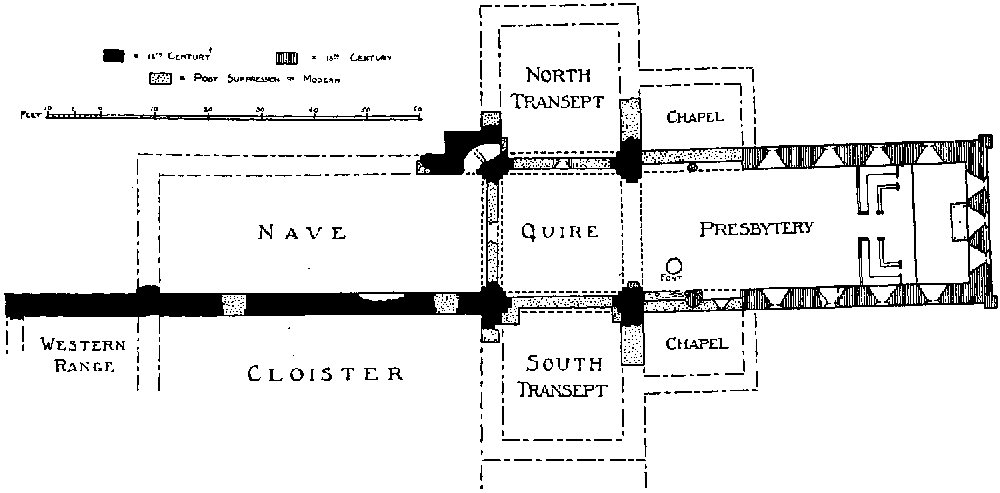
Plan of the Priory Church, Monk Sherborne (used as Pamber Parish Church)
The priory church of ST. MARY and ST. JOHN BAPTIST, known locally as Pamber Church, since it is used by the inhabitants of Pamber, was consecrated by William Giffard, who was Bishop of Winchester from 1107 to 1129.
Of the 12th-century church, which was cruciform, without aisles, the only parts now standing are the arches of the crossing or central tower and a portion of the south wall of the nave. The eastern arm was rebuilt and lengthened about 1220; this with the tower space forms the present chapel-of-ease to Monk Sherborne. The cloister was on the south side of the nave, but nothing is left of it except the doorways in the south wall of the ruined nave.
The dedication by Bishop Giffard can hardly have marked the completion of the first church; all the 12th-century detail remaining in the tower is obviously of later date.
The east arm or presbytery is a simple but finely proportioned building of flint masonry with ashlar dressings, and has at the east angles very slender and graceful clasping buttresses of three stages.
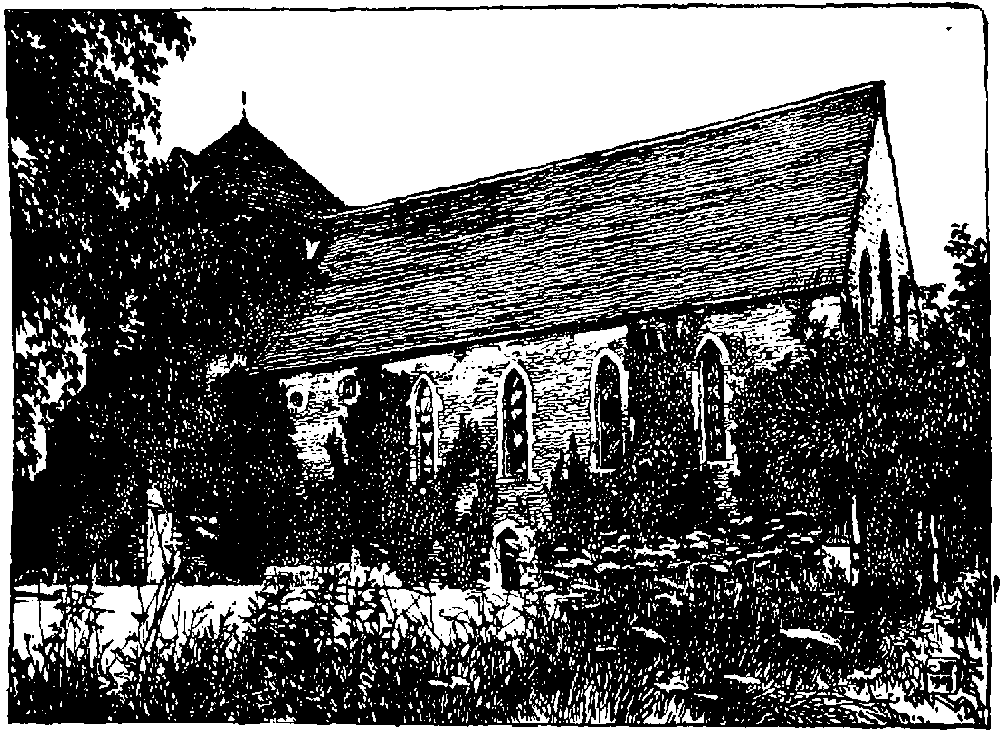
Monk Sherborne Priory Church (used as Pamber Parish Church) from South-east
In the east wall are three lancet windows which are rebated and chamfered outside and splayed all round inside, with a label and a keeled edge-roll from small moulded bases but without capitals, the roll continuing round the head of the window. In either side wall are four similar but shorter lights, without labels.
A moulded string runs round the inside below the sloping window sills, stopping abruptly west of the westernmost windows. Below the first window on the south is a well-designed piscina, with a trefoiled head and engaged jamb shafts with moulded capitals and bases. At the back of the piscina is a narrow shelf.
Under the third south window is a small doorway, doubtless once old but now of modern stonework outside; it has a four-centred head of 15th-century character.
The angles between the chancel and transepts were formerly occupied by small chapels of two bays; these are gone, but the archways opening into them from the chancel remain; they are now blocked up. Each side has two bays, those on the south side appear to have been divided by a circular pillar, now for the greater part buried in a later pier; the jambs of the recesses are chamfered and have partly restored chamfered abaci; the arches are segmental, with keeled edge-rolls, the voussoirs being in many cases old worked stones re-used. The backs of the arches are closed up and form large recesses, which now contain a marble gravestone and the wooden effigy of a knight. In the back of the eastern recess is a small blocked square-headed window. The arches in the north wall have a filleted bowtel instead of the keeled roll, and they are separated by a free eight-sided shaft from which an arch sprang northwards; in other respects they resemble the southern pair, and are also closed up to form recesses for gravestones. High up in the wall above these arches, to clear the roofs of the former north and south chapels, are two small circular lights on either side.
The central tower stands on large round-headed arches, those to the nave and transepts being now blocked with masonry of fairly good character and probably dating from the suppression of the alien priory early in the 15th century. The jambs are of two square orders, those of the eastern arch being mostly of modern stonework; they have plain chamfered abaci and no capitals. The arches are also of two orders; the inner to the chancel arch is chamfered and the outer has an edge roll on the west face; the label is chamfered. The north transept arch is chamfered in its outer order, the inner is square. The opposite arch is square in both orders.
The western arch is slightly richer than the other three; its inner order is chamfered, the outer has a three-quarter edge roll on both faces and the label is moulded. In the filling of the north transept arch is a lancet window of 13th-century date brought from elsewhere. In the west filling is a doorway of 16th-century style but modern stonework, and over it a blocked window now without tracery. An old wood door now used in the village school and said to have been brought with other timbers from the priory was probably the former west door of the building. In the blocking to the north of the entrance doorway is a small blocked opening with a round head on the west; its sill is 5 ft. 10 in. above the floor, and it was evidently a doorway to the stair turret, which rises in the north-west angle of the tower, and is entered from the south by an outside doorway at almost the same level. The turret is patched with modern brick, but is of 12th-century date, and on the ground floor contains a curved passage from the north transept to the nave, to give access to the eastern parts of the church without passing through the quire, which was probably in the first instance under the tower. The upper part of the tower is open to the ground and lighted on each face by a pair of round-headed windows whose inner jambs have edge rolls with bases and capitals, above which the roll continues around the window head. Between each pair of the windows is an arched recess ranging with them and of like detail but having larger capitals. A string cornice runs round below the windows and above them is the floor to the bell chamber, which is contained in the pyramidal roof. The tower was probably intended to have a third stage, but there is nothing to show whether this was ever built.
The presbytery roof, though now mostly modern, preserves what is probably its original 13th-century design with semicircular braces under each rafter and has four unequally spaced tie-beams, moulded with a torus between two rolls, at the west end. The plate is also of 13th-century section, and parts of the old timbers are re-used.
Both transepts are ruined, but the marks of their roofs remain on the tower, and the bonding of the chapels to the chancel may still be seen. The lower part of the south wall of the nave remains overgrown with ivy. It retains the two procession doorways to the cloister, now blocked up, and the return of the west wall of the nave is marked by a masonry projection. The wall continues west of it in the same line and formed the north end of the western range of the claustral buildings. Against the north-west buttress of the tower are a few remains of cinquefoiled 15th-century lights.
The font is of 15th-century date, and stands on the south side of the church; it is octagonal with panelled sides to the bowl inclosing quatrefoils or floral ornament and has a moulded base. Opposite to it is a large mortar fitted with an 18th-century cover and set on a pedestal of broken gravestones, among which is a foliate 13th-century capital. Another smaller mortar, with carved heads at the four projections, is set in the blocking of the eastern arch of the south chapel.
The present chancel screen, set between the second and third windows of the presbytery, is a very solid piece of plain 15th-century character, containing a good deal of old work; it has a central doorway, and probably formed no part of the monastic fittings, and there are some good solid oak benches and poppy-head bench ends which belong to the same work.
There are a number of early gravestones in the church, but the most interesting monument is the wooden effigy of a knight which lies in the western recess in the south wall; he wears a long surcoat with short sleeves over his mail, the rings of which must have been shown by paint, and are not carved on the wood. His head rests on a diamond-shaped pillow, and is protected by a hood of mail. Of his shield the strap only remains, it was doubtless cut in a separate piece of wood, and he wears a sword in a belt on the left side; his legs are crossed and his feet rest on a lion. The work is very good and the details minutely worked where the decay of the wood has not damaged them; the figure rests on a wide plank cut out of the solid with it and is hollowed out behind for lightness. It dates from the second half of the 13th century, and cannot represent John de Port, son of the founder, as commonly said. It is now set on a tomb-shaped block of masonry, on which is a marble grave slab, and there are similar blocks and gravestones in the other three recesses, all of 13 th or early 14th-century date. To the north and south of the altar table are set four similar slabs; the first is very like that in the south recess; the cross on the second is almost obliterated, but the other two have leaves of late 12th or early 13th-century style branching from the stems of the crosses, and one has an inscription running round its moulded edge in early Gothic characters, some of the letters contained within others, as often in 12th-century inscriptions. It reads:—
'+ si quis eris qvi transieris sta perlege plora + svm qvod eris fveram que quod es pro me precor hora.'
At the foot of the cross shaft is an Agnus Dei.
Near the font are a few old tiles, probably 15th-century work; the patterns on them are almost obliterated.
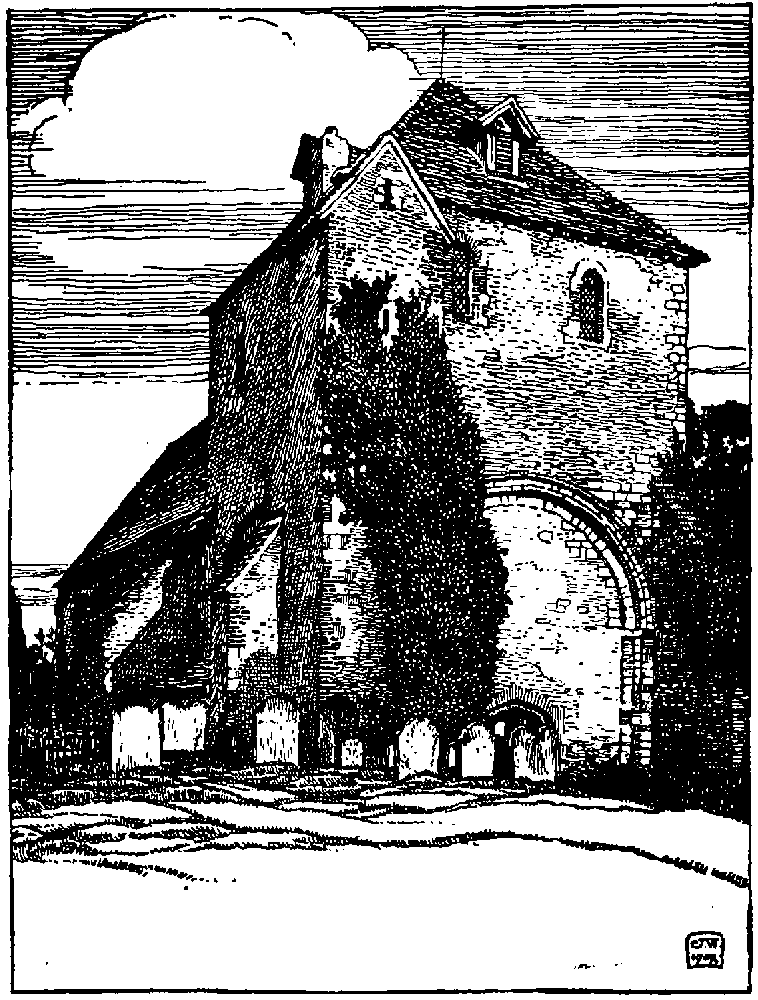
Monk Sherborne Priory Church (used as Pamber Parish Church): The Tower
On the north wall of the presbytery below the string some of the old painted decoration has been uncovered, showing a consecration cross and some winged angels, with a few letters in black letter smalls; the whole is probably of 15th-century date. On the same wall is the brass plate recording Thomas Sympson's benefactions, 1674, as at Baughurst and elsewhere.
The evidences of the arrangement of the church in monastic times are small, and the priory having been alien, and therefore suppressed early in the 15 th century, much of the mediaeval fittings may be parochial and not monastic.
The consecration cross painted on the north wali of the chancel seems contemporary with the paintings of angels close to it, which from their style and the letters of the inscription seem to be not earlier than the 15 th century. The heavy wooden screen, which is a good deal like that of Monk Sherborne close by, is also of 15th-century date, and can only be parochial, and the seats are apparently made up of woodwork of the same character. It is probable that a complete refitting of the church took place after the suppression, and that the monastic arrangements were swept away. The nave, transepts and chapels probably did not long survive the priory, and the blocking of the three sides of the crossing is carefully done, and no doubt mediaeval. The stair turret at the north-west angle of the tower, which is part of the 12th-century work, gives some interesting evidence about the original arrangements. Its ground stage, as already noted, forms a passage from the north transept to the nave, and the stair only begins on the next stage above, and is reached through a doorway immediately over that opening from the passage to the nave. This can only have been reached from a raised passage or gallery, which was probably nothing else than the original pulpitum at the west end of the 12th-century quire, the position of which has been already referred to. When the eastern arm was rebuilt and lengthened in the 13th century the quire was probably moved eastward, and the modern repairs to the responds of the east arch of the tower suggest that they have been formerly cut back for the fitting of stalls. When the nave was destroyed the access to the upper doorway in the north-west turret was provided for by making a doorway in the blocking of the west arch of the tower, as already noted.
There are four bells: the treble was dated 1598, but has been recast by Taylor in 1851; the second is by Joseph Garter, 1579, and the inscription is obviously the continuation of a verse originally begun on the treble, 'That has sent us thy holy worde'; the third is also by Joseph Carter, 1582, and is inscribed: 'O Lorde even for thy holy name'; and the tenor originally of 1579 but recast in 1850 by Taylor: 'Inflame our hearts to love the same.'
The plate consists of a silver Elizabethan communion cup, paten cover and alms dish. There are also two other services, one of which is of silver gilt.
The registers of the parish begin in 1661; the first book contains baptisms thence to 1812, burials same period and marriages to 1754. The second has the marriages from 1754 to 1812.
Advowson
The church of Monk Sherborne with all tithes (fn. 67) was granted to the priory at its foundation by Henry de Port (fn. 68) The advowson was taken into the king's hands in the 14th century on account of the war with France, (fn. 69) and was subsequently granted by King Edward IV to Queen's College, Oxford. (fn. 70) The Provost and fellows of the College are the patrons at the present day. (fn. 71)
A chantry was founded in the 15 th century by Queen's College, (fn. 72) and the priest appointed to serve it was accustomed 'to minister there as in a chapel of ease' to the inhabitants of Pamber who lived close to the priory and had no parish church. (fn. 73) The result was that by the time the chantry was dissolved in 1547 the people of the district had come to believe that the priory chapel was their church, and they subsequently brought a suit in Chancery against the Provost and fellows for neglecting to provide a priest. (fn. 74)
In the 13 th century there was also a church at Chineham. (fn. 75)
Charities
In 1674 Thomas Sympson by will gave to the poor of six parishes, including this parish, the sum of £15 yearly for ever, to be received out of his land in this parish and the parish of Baughurst, £2 10s. each parish. In 1905 twelve persons received 4s. 2d. each.
The annual sum of £1 3s. 4d. is received from Queen's College, Oxford, in respect of a gift of Adam de Port, and distributed to the poor on 2 January in every year The same college also remitted £4 a year to the schools, claimed to be a voluntary payment.
